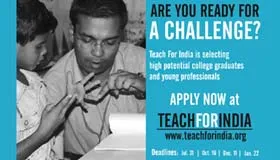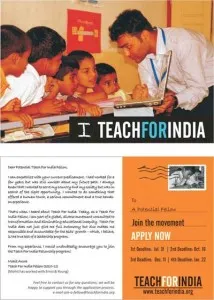Shaheen Mistri, Teach For India: “Every child is capable of achieving great things, if the opportunities are given.”

“Education is hanging around until you’ve caught on.” – Robert FrostIt’s strange how a clever little quip by an American writer applies so accurately to India’s primary education scenario, more than 60 years after that comment was made. Surely, it’s not a pretty picture. A Teach For India recruitment collateral claims that one in three children who start primary school drop out by the time they reach the fifth grade.
So, what’s being done to keep our children in school? What’s being done to ensure that the next generation of Indians make it past the fifth grade? Pose these questions to any group of young people in the country today and it’s likely that an embarrassed silence is all that you’ll able to wriggle out of them. The Teach For India fellows, however, are an honourable exception.
Teach For India (TFI) is a nationwide movement that aims to bridge the educational gap in India by placing outstanding college graduates and young professionals (referred to as TFI Fellows) in low-income schools to teach full-time for 2 years. The organization's mission is to build cohorts of young leaders who will eliminate inequity in education.
We at YourStory.in caught up with Shaheen Mistri, the woman behind this silent revolution to know more about how she and her TFI fellows are helping India strengthen its primary education system. Shaheen, currently the CEO of TFI, started it in 2007 based on the proven model of Teach For America that started 20 years ago in the US. In this chat with YourStory, she speaks about moving beyond being a supplemental model to building a robust school system that offers quality education. Read on to know more:
You started your first educational initiative Akanksha when you were 18 years old. Clearly, education’s something you’ve felt very strongly about right from the beginning. What was the plan and how has it evolved?
Well, with Akanksha, we tried to set a bar for excellence. We believed that young people could make a difference to the lives of underprivileged kids through education and the results reinforced our belief. But the truth is, the scale of problems is massive in India. The stress on the quality of education, therefore, is low.
With TFI, we’re trying to set up excellent school for the poorest kids. We’re working towards raising the standard in terms of quality education, moving from the supplemental model to building simply outstanding schools.
At the same time, we understand that the definition of excellence is constantly evolving. But the basics remain the same. It’s always been about giving kids the tools and the mindset required to alter their life path. And we look at it as a sum of the four parts – academics, the values and mindset required to maximise potential, student interest & aspiration and eventually, setting up the pathway to opportunities & greater choice. We believe deeply in the fact that every child is capable of achieving great things if the opportunities are given to them.
But as a young person coming to India for the first time, deciding to educate kids from underprivileged backgrounds must have been a tough decision.
To be honest, I really don’t know whether I’d call it a tough decision. I started Akanksha instinctively. I was visiting my grandparents in Mumbai and during that visit, the inequality in the standard of education between the private and public schools struck me. It was clearly one of those heart over head things.
I guess my background helped. I had the privilege of having been in over 10 different schools when I was growing up. It helped me understand people, how to mobilize them and how to adapt to different systems. Those lessons kept me in good stead.

Let’s talk about Teach For India. You’re asking bright young people to invest two years of their lives in improving the lives of children through education. Take us through the challenges of building this sort of a movement.When it comes to TFI, we’ve had different challenges at different points of time. At the crux of the movement are the really idealistic, brilliant people who come forward to teach. But it’s awfully hard for a lot of those people to commit two years to it. There’s societal pressure. The classroom atmosphere isn’t easy to succeed in. We’ve had better classrooms lately. But it can be pretty hard.
Funding is also an issue. TFI is doubling in size every year. We had a cohort of 80 Fellows joining us in 2009 and we have now grown to approximately 400 Fellows. So, sometimes, even growth can be a threat. We started out with Mumbai and Pune. We went to Delhi after that. Now, that’s out of my network. But we managed. We’re going to Chennai and Hyderabad next year. So, there’s also the aspect of maintaining quality across locations and cultures.
I think I also suffer from all the startup anxiety around scaling. We make a lot of mistakes. Actually, we make mistakes all the time. But steadily, we’re figuring out a balance between the mission and the partnerships to make this whole thing viable. We have over 90 people as staff already and that’ll double next year. It’s terribly important that they’re in line with the values and the culture of TFI. Ramping up can be scarily exciting.
There’s a lot of buzz about harnessing technology to improve the quality of education. What’s your take on that?
Well, technology is awesome as long as it stays in its place. When there’s talk of replacing teachers, I get queasy. That simply cannot be done. That’s the determinant of the quality of education. And that’s only even more relevant for primary education. You need a lot more than just academic content. That’s where technology is good and that’s where it’s necessary. School leadership also plays a big role in ensuring that technology gets harnessed. And at the end of the day, if technology can help log and assess data at the granular level, then it’s invaluable. The importance of that cannot be overstated.
What is the vision, ultimately? What are the milestones that you’re looking to hit in the near future?
The ultimate vision, clearly, is for every kid in the country to have an excellent education. The aim is to impact 65000 children, in 8-10 cities, and their surrounding rural areas, within the next 5 years. We’d like for the cohort to continue doubling in size and have over 2000 TFI Fellows. We’ll also have 3000 alumni by then and they are as important as the teachers. We’d like for them to serve as examples for other young people.
When it comes to the primary education system, there are a number of stereotypes that are bandied about. Can you separate fact and fiction for us?
There’s a stereotype that parents of kids from low-income groups don’t care about educating their children. We don’t agree with that at all. That’s just not true. The fact is that those parents don’t know how to engage with the system. Schools keep them out of the loop. There’s tremendous potential for improvement there.
Also, teacher absenteeism isn’t as bad as it is made out to be. I mean, if you go into the reasons, it’s usually due to things beyond the control of the teacher. The exposure, the validation, the space and the time required to teach well are missing. However, there is a lot of interest in wanting to teach better.
The quality of education, however, is appalling. Kids in the third or fourth grade are kindergarten levels. And it’s not getting any better. That’s something we’re concerned about and we’re trying to deal with that.

The Teach For India Fellowship is said to be a highly selective program, with only about 8% of the applicants getting through. Also, there are those who say that TFI recruits only those from premier institutes like the IITs and the IIMs.It is definitely a selective program. Last year, we got about 4700 applications and about 250 eventually joined the program. And let me tell you that the selection process doesn’t focus on the institute/s from where an applicant has graduated or the organizations where he/she may have worked. We get a lot of our people from IITs and IIMs because we go looking for people there. We do that simply because they give us a greater pool to choose from. We have limited funds and hence, we have to be selective about where we go looking.
That said, the process does not discriminate in any way. We’re very clear about the cohort needing diversity. Here we are solving India’s primary education problem. But getting in the best Fellows and ensuring diversity is something that we still struggle with. We’re, in fact, looking for bright people from Tier 2 and Tier 3 institutions. And if you see the Teach For India presentation, it has every college’s name and not just the “premier” ones.
We understand that the TFI application deadline is tomorrow.
We have four deadlines. The first one was in June. The second one is tomorrow (16th October 2011). We have the third one coming up on 11thDecember 2011 and the last deadline is 22nd January 2012. However, we strongly encourage people to apply as soon as they can to better their chances of getting selection for the Fellowship.
The Teach For India board is filled with prominent personalities like Anu Aga, Nisa Godrej, Nita Ambani, etc. How do they contribute to TFI?
We’ve handpicked the board so carefully that we’ve landed up with an absolutely awesome group of people. They ask really difficult questions and they’re very good at leaving the work to us and not intervening. For instance, take Ajit Rangnekar, the Dean at the Indian School of Business (ISB), Hyderabad.
For TFI’s Hyderabad launch, he took it upon himself to meet all the influential people personally and invite them. Ashish Dhawan from Delhi is another champion. The sort of effort and dedication that you see from them is insane. Anu Aga believed in us when no one did. She backed up that faith with money and her time. The contribution of the board has always been very critical.
So, what’s the focus of educational reform at your end?
We’ve got to have clearer learning standards. We need to be absolutely sure about where the kids need to be at the end of each year. Our system is rote-driven. You don’t have a clear idea of what they’ve learnt till the class X board exams. There’s a need to view and recognize skills as the starting point. We’ve got multiple people working on the curriculum. It has to be of certain standard while remaining flexible. The curriculum must be customizable. But the milestones must be common. I’m definitely not for over-standardization of education. The teacher definitely needs to have a choice, with respect to the tools used to deliver education.
To apply for the Teach For India Fellowship, click here. Please do bear in mind that the second deadline for applying to a be a part of TFI ends tomorrow (16th October 2011).
Also, do let us know what you think of this story by writing to us at [email protected].
Sriram Mohan | YourStory.in | Bangalore | 15th October 2011






